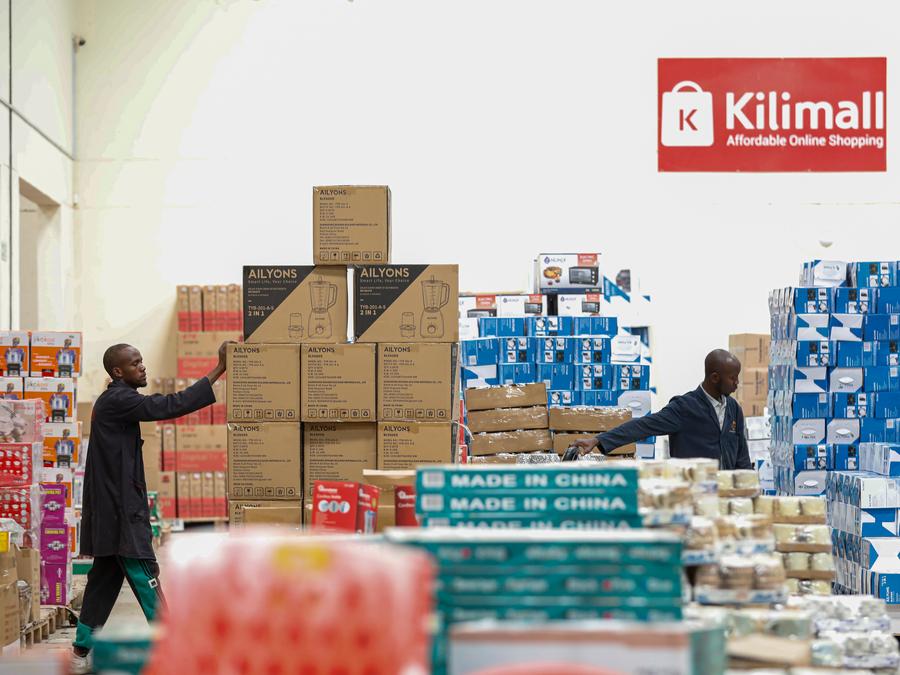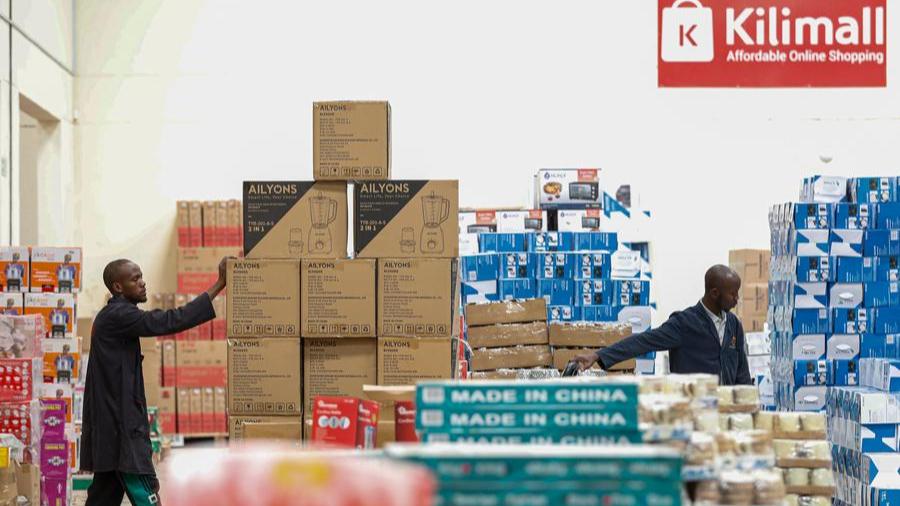
Staff members of Kilimall work at a warehouse in Mlolongo, Kenya, Nov. 10, 2023. (Xinhua/Li Yahui)
BEIJING, June 26 (Xinhua) -- To further bolster cross-border e-commerce, nine ministries of China including the Ministry of Commerce have jointly issued a document on expanding cross-border e-commerce export and promoting the construction of overseas warehouses, which outlines multiple initiatives aimed at promoting the high-quality development of overseas warehouses for cross-border e-commerce.
Highlighting a series of recent policies and initiatives supporting foreign trade, "cross-border e-commerce" and "overseas warehouses" emerge as pivotal components.
Over the past five years, China's cross-border e-commerce trade volume has grown more than tenfold. Preliminary statistics indicate that there are over 120,000 cross-border e-commerce entities nationwide, with over 2,500 overseas warehouses covering a total area of over 30 million square meters, reported Economic Information Daily recently.
-- Warehousing redefined, bridging sellers and international customers
An overseas warehouse is a digitally and intelligently operated facility established overseas through self-construction or leasing, facilitating the final stages of cross-border trade.
According to industry experts interviewed by Economic Information Daily, traditional cross-border logistics typically involve international shipping processes such as customs declaration and clearance, normally taking 5 to 10 days to reach customers. Items dispatched from overseas warehouses, however, can reach customers within 1 to 3 days.
Beyond serving as storage abroad, overseas warehouses enable end-to-end visibility in order processing, shipping, transportation, and delivery. They provide consumer insights and customized data analysis reports. By integrating logistics, warehousing, finance, and distribution resources through digital management, overseas warehouses support the evolution of cross-border e-commerce in technology, models, and supply chains.
"It enhances both shipping efficiency and user experience," remarked Ye Hanmei, Sales Director of Shenzhen Baosen Suntop Logistics Co., Ltd., which has established three overseas warehouses in the Netherlands, Germany, and the United Kingdom since 2020.
As vital new infrastructure for supporting cross-border e-commerce, overseas warehouses bridge the gap between Chinese sellers and international customers, streamline customs processes, accelerate trade turnover, and address refund and return challenges, significantly enhancing the global competitiveness of Chinese manufacturing.
-- Development of overseas warehouse boosted, driving innovative foreign trade models
With the ongoing development of globalization, Internet+, and big data, new and diverse models of foreign trade are emerging.
Establishing overseas warehouses involves more than just renting space abroad; service providers must demonstrate financial capability, operational experience, and the ability to navigate local political, cultural, and regulatory differences.
The recent document proposes 15 targeted measures, including strengthening industry organization and talent development, facilitating financing channels for cross-border e-commerce enterprises, and enhancing cross-border data management and service levels.
To promote overseas warehouse development practices, the Ministry of Commerce has issued practical cases: Some overseas warehouses manage over a million items with accuracy reaching 99 percent; some develop tailored marketing strategies based on local market nuances; and others establish legal, financial, and tax teams overseas to help clients navigate the infringement of intellectual property rights and various tax risks.
-- Broad development prospects expected for overseas warehouses construction
From a policy perspective, both national and local governments are intensifying efforts to support overseas warehouse development as a catalyst for exploring new dynamics in foreign trade.
From a demand side, the global e-commerce market is expanding rapidly, propelling the growth of the cross-border e-commerce industry and offering substantial room for overseas warehouse expansion.
Pinduoduo's cross-border e-commerce platform, Temu, recently launched its Brazilian site, marking a significant milestone in its South American market strategy with its 70th country site.
As of April 2024, Alibaba Group's cross-border platform, AliExpress, reported approximately 8.58 million members in South Korea, doubling from April 2023.
According to a recent study by Roy Morgan in Australia, more than 2 million Australians shop monthly on Chinese cross-border e-commerce platforms SHEIN and Temu. Exclusive data reported by Germany's Handelsblatt indicates that one-fourth of Germans have made purchases on Chinese e-commerce platforms.
By reducing trade intermediaries, overcoming time and space constraints, and advancing logistics technology and systems, cross-border e-commerce is emerging as a new engine for China's foreign trade development.
In the first quarter of this year, China's cross-border e-commerce imports and exports totaled 577.6 billion yuan, with a 9.6 percent increase. Exports reached 448 billion yuan, up 14 percent, accounting for 7.8 percent of total exports and boosting export growth by more than one percentage point.
As supportive policies continue to unfold, the development of overseas warehouses will propel cross-border e-commerce forward. More Chinese brands will expand globally, while quality foreign goods will also find their way into China.
(Edited by Gao Jingyan with Xinhua Silk Road, gaojingyan@xinhua.org)




 A single purchase
A single purchase









